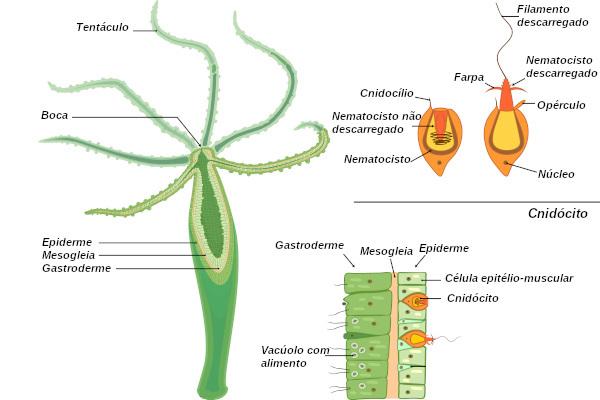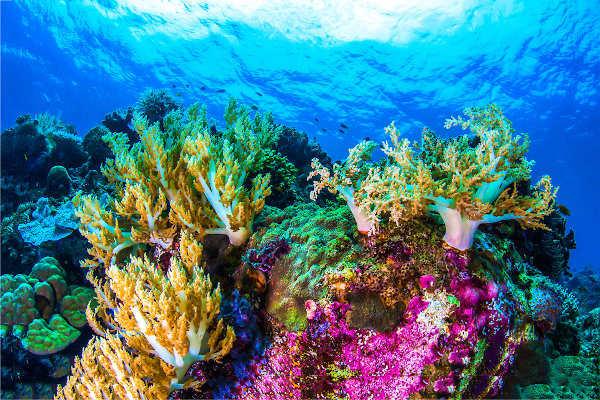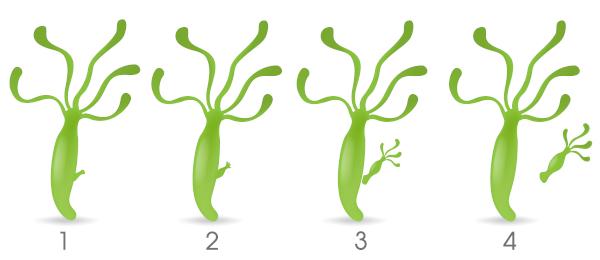the cnidarians (phylum Cnidaria) are a group of animals with a relatively simple body organization, but more complex than that presented by sponges. In this group we have the emergence of tissues, which allow the development of important functions, such as swimming and the ability to respond to stimuli.
the cnidarians present sessile and mobile forms, which are called polyps and jellyfish, respectively. Currently, about 10,000 species of cnidarians are known, the majority being marine. Examples of cnidarians are the sea anemones and the Jellyfish.
Read too: Porifers - general characteristics, physiology, reproduction and importance
Structure of a cnidarian's body
The cnidarians, also known as coelenterata, have a relatively simple body structure, which resembles a large sack. These animals have radial symmetry, that is, similar parts of the body are organized and repeated around a central axis.

Cnidarians have, inside, a compartment called the
gastrovascular cavity, in which the digestion process takes place. This cavity is connected to the external environment by a single opening, which acts as the mouth and anus. is called oral surface the one with the mouth and aboral surface the side opposite her.Around the mouth of the cnidarian, it is observed tentacles that help capture food. In these tentacles is found a great amount of cells specialized calls of cnidocytes, that occur throughout the epidermis, but are more numerous in this region. A cnidocyte is characterized by being a round or ovoid cell and having organelles calls from cnidas, which are capsule-shaped.
You nematocysts are the most common type of cnidas. They are a capsule that contains a coiled filament, which is fired when chemically or mechanically stimulated. This filament pierces the prey's body and ensures the injection of a stinging substance, which can cause painful injury, paralysis and even death.
The cnidarian body wall is formed by two cell layers: a outermost epidermis, which is derived from the ectoderm, and an inner layer, called the gastroderm, which is derived from the endoderm. the cnidarians are animals diblastic, because their bodies are formed on the basis of two embryonic leaflets: a ectoderm and endoderm. Between the gastrodermis and the epidermis there is the mesoglea, which has a gelatinous consistency. The mesoglea usually has no cells.
Polyps and Jellyfish

The body structure of cnidarians has two variations: the polyp and the jellyfish. Some cnidarians spend their entire lives as just one form, that is, being a polyp or a jellyfish. Some species, however, have a polypoid and a medusoid stage during the life cycle.
Polyp: life form usually sessile, that is, that does not have an active movement. Some species, however, are able to move when threatened, for example. Polyps have a cylindrical shape and are associated with the substrate through the aboral surface. The end that is not attached to the substrate presents the animal's mouth, surrounded by tentacles that help it to capture its prey. Hydras and sea anemones are examples of polyps.
Jellyfish: way of life that actively moves. Jellyfish have a bell-shaped and downward-facing mouth as well as their tentacles. They have a well-developed mesoglea, unlike the polypoid form. Jellyfish are examples of jellyfish.
Physiology of the cnidarians
The cnidarians are animals with a very simple body, not showing complex systems as in the body of the vertebrates. Let's see, below, some of the important physiological processes that occur in the bodies of these animals:

Digestion in cnidarians: é extracellular and intracellular. It starts inside the gastrovascular cavity, where enzymes are released, and then it is completed inside the gastrodermal cells, which line this cavity. What has not been absorbed by the animal comes out of the body through the mouth.
Excretion and gas exchange in cnidarians: they do not have an excretory system, thus, the excretion of products resulting from metabolism is carried out, by diffusion, through the body surface. At gas exchange these animals also occur on the surface of their bodies.
Perception of stimuli in cnidarians: they have nerve cells scattered throughout their bodies. This allows impulses to be transmitted in all directions. The nervous system of these animals is called diffuse nervous system. Cubozoa present complex eyes, which have a lens and a retinal arrangement with sensory cells. Jellyfish also have structures called statocysts, responsible for the sense of balance.
Know more: Invertebrate animals - characterized by the absence of spine and skull
Classification of cnidarians
We can classify the phylum Cnidaria in four classes: Hydrozoa, Scyphozoa, Cubozoa and Anthozoa.

Class Hydrozoa: hydrozoans have representatives with a wide variety of forms and life cycles. Most alternate, in their life cycle, polypoid and medusoid forms. THE hydra is an example of a hydrozoan.
Class Scyphozoa: it is observed that the dominant life cycle stage is that of jellyfish. Polyps are usually small and resemble young jellyfish. In some species, the polyp phase is not observed. A representative is the Aurelia.
Class Cubozoa: cnidarians with cube-shaped medusoid stage. This group has one of the deadliest species known: a sea wasp (Chironex fleckeri). This species has a more potent toxin than the venom of some snake species, which can cause severe pain, difficulty breathing, cardiac arrest and death in a few minutes.
Class Anthozoa: anthozoans do not have the jellyfish stage during their life cycle. Polyps in this class can be alone or forming colonies. Anemones and corals belong to the group.
Read more: Coral reefs – rich in biodiversity, provide shelter and protection
Reproduction of cnidarians
Cnidarians can breed fromsexual way orasexual. In hydras, the budding, a type of asexual reproduction, it is very common in the hottest seasons of the year. In this process, a bud develops on the animal's body wall, which stands out and becomes an independent hydra. Budding is also observed in other cnidarian species.

The cnidarians also breed from sexual way. We will exemplify this type of reproduction citing the reproduction of hydra, which, in their majority, are dioecious (they have separate sexes).
In these animals, sperm are released into the water, which finds the egg that had been produced in the ovary and finds itself in the body of another hydra. After fertilization, a series of cell divisions ensues. As these divisions occur, a kind of capsule forms around the embryo. This capsule breaks and from it emerges a young hydra. In some species of cnidarians, a seedling larva.
Generation alternation in cnidarians
In some species of cnidarians, the so-called alternation of generations or metagenesis. in the hydrozoan Obelia, for example, we have an asexual polyp phase and a sexual jellyfish phase.
In this cycle, the polyp stage reproduces by budding, giving rise to several jellyfish. Male jellyfish produce sperm and female jellyfish produce eggs. The gametes are found in water and form a zygote, which will lead to the formation of a planula larva. This larva attaches to the substrate and develops into a new polyp.
By Vanessa Sardinha dos Santos
Biology teacher
Source: Brazil School - https://brasilescola.uol.com.br/biologia/filo-cnidaria.htm
